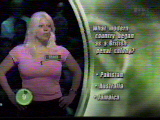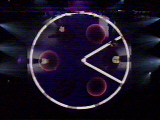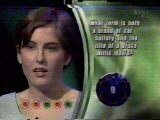Russian Roulette
From RulesWiki
| RUSSIAN ROULETTE | |
| The opening title for "Russian Roulette". | |
|---|---|
| Airdates: | GSN June 2002 - June 2004 |
| Host: | Mark L. Walberg |
| Announcer: | Burton Richardson |
| Producer: | Gunnar Wettenburg Productions |
Contents |
Gameplay
Front Game
Four players competed, all of whom began the game with an opening stake of $150. One player, who was randomly selected at the start of the game, was deemed the "challenger", and was shown a trivia question. The challenger then chose one of his opponents to charge with answering the question. Three possible answer choices were given, and the player had 10 seconds to answer. If correct, the player added $150 to his score and became the new challenger; otherwise, all of his money was lost to the current challenger, and the player was forced to play Russian Roulette in order to stay in the game.Each player is standing on top of one of six trap doors. When called upon to play Russian Roulette, the player must pull a lever, which causes one or more "drop zones", denoted by a red border around the trap door, to spin around the chambers in the studio. For the first question, only one drop zone is in play; this number increases by one on each subsequent question, up to a maximum of five. If the player is still standing on a safe zone when the drop zones stop spinning, the player remains in the game and takes over as the new challenger. If the player is standing on a drop zone at the end of the spin, however, the trap door opens under the player, causing him to fall through the floor, eliminating him from the game and automatically ending the round. Should time run out in the round before a player drops, the player with the most money is deemed safe from elimination, and invited to pull a lever at center stage to determine which opponent will be removed from the game. (If there is no outright leader, the host pulls the lever, and every player is at risk.) If a player had any money in his score at the time of elimination, it is split evenly between the remaining players.
The second round is played in the same fashion as the first, except that each question has four answer choices, and are worth $200 each.During the third round, each question is worth $250 ($300 in season 1), and instead of choosing an opponent to answer the question (as there are only two players left), the challenger is given the choice of either forcing his opponent to answer the question, or answer it himself. Play continues until either a player drops out of the game, or time is called, at which point the player with the least amount of money is eliminated. The last player remaining wins the game and gets to keep any money he earned (as well as any money that his opponent had at the time of elimination).
Bonus Round
The player now has 60 seconds to answer a series of questions. During the show's first season, the player had to answer 5 brain-teaser or multiple-answer questions. (The player could talk out loud as much as he wanted, but a player also had to preface his official answer with "My answer is..." to be counted as an official answer.) In the second season, the player had to answer 10 simple trivia questions, each with three possible answer choices. A player could pass on a question if so desired, but would have to answer it later if time was left. If time ran out or the player answered a question incorrectly, the player was immediately dropped, but was awarded money for each right answer in the round before being eliminated; $500 in the first season and $300 in the second. If the player was able to answer every question correctly before time expired, however, he won $10,000.Those who won the $10,000 were then given a choice to either take the money and leave, or give it back for the opportunity to play Russian Roulette one last time, with one drop zone in play for every 10 seconds that elapsed in the bonus round. (Hence, a player who completed the bonus round in 53 seconds had to contend with 5 drop zones, while someone who finished in 47 seconds had only 4 drop zones.) If the player survived that final spin, he won $100,000. If the player dropped, however, he lost the $10,000, but all front game winnings were still safe. Even if a player refused, he was allowed to pull the lever (after stepping off the trap door) to see if he would have won.
Notes
- Players who fell through the trap doors fell three feet onto a padded mat below them, and were instructed to crouch and roll off the mat so as not to reemerge from the hole after being dropped. Among the the two seasons, only one injury--a sprained ankle--was ever reported; however, players were required to sign liability waivers to be on the show.
- During the show's run, three contestants won the $100,000 top prize. After two players won $100,000 in the first 65 episodes, the bonus round was retooled and only one contestant won--with just one open drop zone. (In the first season, one winner had a 50/50 shot, and the other 33%.)
- Mathematically speaking, risking the $10,000 to win the $100,000 was always a "good bet", because even if a player had the maximum five drop zones in play, it would still give the contestant a minimum 16.67% chance to multiply the endgame winnings tenfold.





